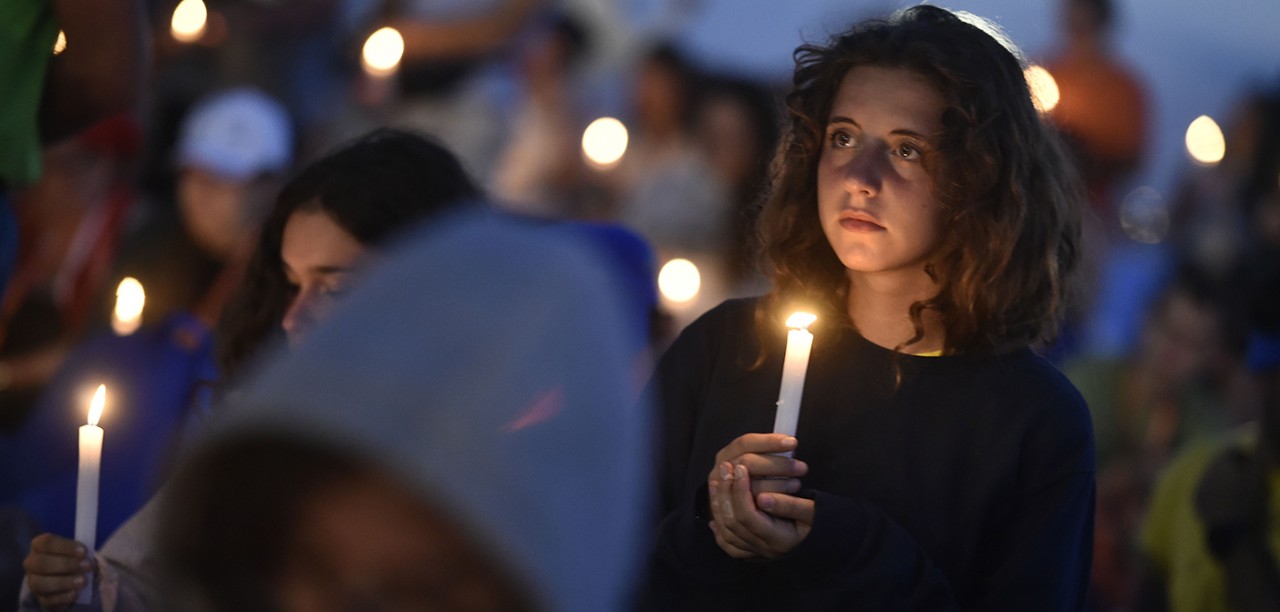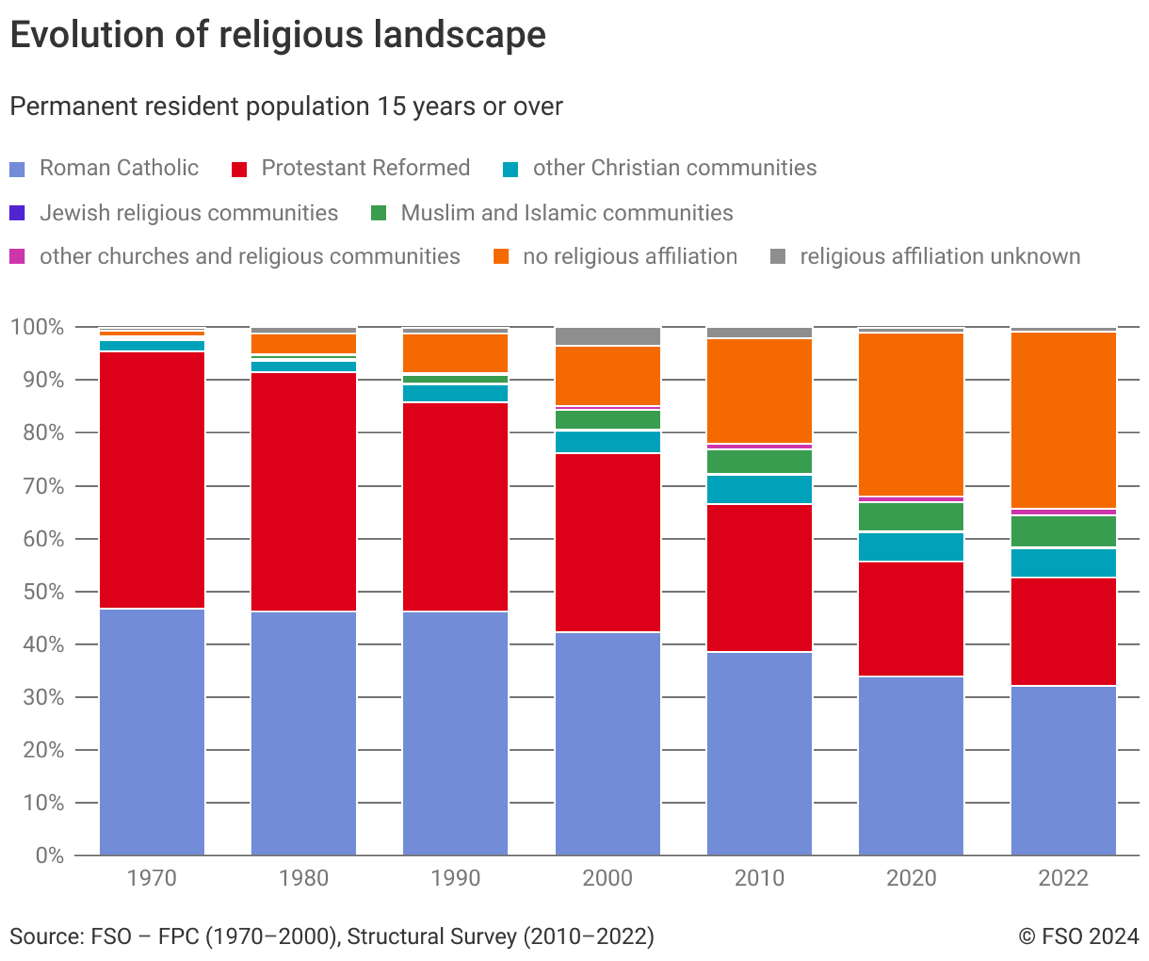

Source: Becket Fund.

Wheaton College (source: DiscoverDuPage).
Benne, who has previously researched these “critical mass” schools, was surprised at their low scores— the Lutheran schools St. Olaf College and Valparaiso scored 5.5 and 8.5, respectively; Notre Dame and Baylor did somewhat better, respectively receiving 15.5 and 13. Only Wheaton College among those in the “critical mass” group scored a high 22. Some of the strongest Protestant schools come from what Glanzer calls “independent, low-church Protestant cooperative endeavors,” with 17 of these schools scoring 20 and above. Thirty-four evangelical schools associated with the Consortium of Christian Colleges and Universities also scored 20 and above. The evangelical standard bearer Biola University scored a 26. Of the Lutheran schools, those affiliated with the Lutheran-Church Missouri Synod scored much higher than the mainline Evangelical Lutheran Church in America and independent Lutheran institutions. A segment of Catholic schools also scored fairly high—34 scored above 12.5 and 23 above 15. The new Catholic schools started by committee lay leaders, such as Christendom and Wyoming Catholic, scored the highest among colleges and universities in that tradition, both 20.5. Benne concludes that Glanzer’s work shows that without a strong, “explicit, orthodox Christian mission” there will be a “slow accommodation to secular, elite culture” among Christian colleges.
(First Things, https://www.firstthings.com/web-exclusives/2024/01/only-the-orthodox-will-survive)

Women clergy protest (source: Afro News).
While mainline female clergy have long been more supportive of marriage equality than their male counterparts, after the Supreme Court’s Obergefell decision supporting marriage equality that chasm has widened considerably. Support for marriage equality is now nearly universal among female clergy members, at 93 percent, while only 75 percent of male clergy members say the same. Women in the clergy are more pro-LGBTQ on almost every measure compared to men; for instance, 86 percent of women, compared to 64 percent of men, oppose allowing small business owners to refuse to provide products or services to LGBTQ people on the basis of their beliefs. In a similar way, the persistent gap between male and female clergy over abortion has remained strong. In asking about the overturning of Roe v. Wade, the researchers found that “a deep gender gap on abortion attitudes remains: while most men clergy opposed the overturning of Roe (69 percent), nearly all women clergy (91 percent) opposed the decision.” Maintaining the trend, female clergy members are also more likely than male clergy to embrace religious pluralism, such as the view that the U.S. would benefit from having more elected leaders who follow religions other than Christianity or who are not religious (62 percent compared 43 percent). Male clergy are also substantially more likely than female clergy to agree that “America is in danger of losing its culture and identity (40 percent versus 24 percent).”
(Religion Dispatches, https://religiondispatches.org/study-shows-mainline-women-clergy-are-significantly-more-progressive-than-their-male-counterparts/)

Using the last three years of the Cooperative Election Study, Burge attempts to estimate the relative size of these groups at the state level. He finds Mississippi to be “the state where church-going evangelicals outnumber cultural evangelicals by the largest margin,” while cultural evangelicalism tends to be prevalent in “a weird mish-mash of a bunch of states…[such as] Kentucky, Minnesota, Oklahoma, Washington, Ohio, Iowa, Montana and Nevada…In my mind, this reinforces the narrative that the primary/caucus process is just a mess. Both Iowa and New Hampshire score very high on the cultural evangelical quotient. Then it jumps to South Carolina, which has a whole lot more church going evangelicals. But it’s pretty amazing to note how many states [there are] where the active evangelicals only outnumber the cultural evangelicals by a few percentage points.” Burge finds that Southern states, including Arkansas, Tennessee, South Carolina, Louisiana, and Mississippi, have seen the largest increases in cultural evangelicals, with low-attendance evangelicals increasing by upwards of four percentage points during the last decade.

The report notes the importance of monitoring the frequency with which leaders have been having these thoughts. In the fall of 2023, 13 percent of religious leaders reported having thought “fairly or very often” about abandoning the pastoral ministry, while 10 percent said they considered leaving their current congregation that often. These percentages are larger than they were in 2021, although they still represent a small fraction of the country’s total religious leadership. The researchers write that the “overall level of health and wellness exhibited by clergy is impressive—especially set against the backdrop of the pastoral discontentment results.” More than mental health, it was more often congregational conflicts and the degree of closeness between clergy and congregation members that seemed to have the most impact on thoughts of leaving. As for leaving the ministry altogether, the survey found that a clergy person’s employment status in the church was a significant factor. If the leader is employed full-time, they are more likely to consider leaving the ministry than if they serve part-time. Catholic and Orthodox priests were least likely to entertain such thoughts, while mainline Protestant clergy were the most likely. Even though a large percentage of evangelical Protestant clergy also ponder leaving the ministry, proportionately fewer of them do so in comparison to their mainline Protestant peers. The survey did find that the rosier the church’s outlook for the future was, the brighter the clergyperson’s thoughts were regarding ministry.
(The report can be downloaded from: https://www.covidreligionresearch.org/wp-content/uploads/2024/01/Clergy_Discontentment_Patterns_Final.pdf)

Source: Givelify.
The study confirms that the collection plate has moved to online platforms, with 98 percent of places of worship now offering digital giving (a sharp increase from 64 percent before Covid). It was also found that 88 percent of people of faith used online platforms to donate to organizations, causes, or people they supported in 2023. Differing motivations among the generations also played a role in the types of giving reported. For instance, millennials and Gen Z faith-based individuals were much more likely to report that addressing social justice was a major reason for their charitable giving. The report forecasts increased generosity and a commitment to do more in the years ahead. While more than half of faith leaders are concerned that the state of the economy will negatively affect their organizations’ finances, 95 percent of individuals who gave money to their places of worship in 2023 want to give the same or more in 2024, and almost the same percentage of people of faith who donated money to nonprofit organizations in 2023 want to give the same or more in 2024.
(The report can be downloaded from: https://www.givelify.com/giving-in-faith/)

Source: David Goodhew.
Although some of the smaller rural dioceses shrank less during the pandemic, this is largely because they already had a small number of children and families—the population that was more likely to stop attending during Covid. Between 2019 and 2022, Sunday attendance for children declined 23 percent overall, with some dioceses showing much worse figures. For example, the Diocese of Canterbury had 1,600 children in Sunday worship in 2019, but by 2022 it only had 1,000, a drop of nearly 40 percent. Children’s average weekly attendance across England dropped 28 percent between 2019 and 2022, a decline of over a quarter in three years. By the average weekly attendance measure, the number of children in the church halved in the decade leading up to 2022. “The net result is that the church has markedly aged since COVID…Worshiping communities markedly aged during 2019–22, with 36 percent of the church being over 70, whereas 13.5 percent of the population of England are over 70.” Goodhew concludes that the C of E is on the same path of ecclesiastical demise that befell the United Reformed Church. “As congregations age, they struggle to fill key posts—wardens, treasurer. They stop being composed mostly of people in their 70s and become composed mostly of people in their 80s—and then they stop. There comes a point when decline tips over into being unviable and that point is at hand for many congregations.”
(Covenant, https://covenant.livingchurch.org/2024/01/08/after-covid-the-deepening-decline-of-the-church-of-england/)

Source: Dicastery for Laity, Family and Life, Vatican.
A recent survey of French youth finds a similarly low rate of practice and affiliation relative to other European youth, but also finds that those who believe tend to intensify their relation to religion, with 53 percent of young Catholics and 85 percent of young Muslims claiming that religion plays an important role for them. The survey conducted by Kantar in cooperation with academic institutions and released in early December 2023 (La Croix, Dec. 6) found that 43 percent of young French people believe in God, 22 percent are self-described Christians (18 percent Catholics), and 12 percent say they are Muslims. The survey found that 52 percent have turned their back on religious institutions, stating that they are affiliated with no religion. Moreover, a number of them stress that religion should not influence society and see any such influence as a negative development. Believers are thus a minority among young French people.
(Journal for the Scientific Study of Religion, https://onlinelibrary.wiley.com/journal/14685906)
The nones tend to be younger than the average population, with 42 percent of the people in the 25-to-34-year-old age group having no religious affiliation. Thus a further increase is inevitable, with various consequences (including for the financial resources of the established churches). Two thirds of the nones used to belong to a religion during their childhood, but either had no faith, lost it, or came to disagree with the views of their religious denomination. However, one third of the nones see themselves as spiritual. Nine percent of the population in Switzerland attends a religious service at least once a week, and 24 percent report praying every day or nearly daily.

The fact that the nones are now the largest group in Switzerland is not surprising and confirms a trend observed there as well as in other European countries. In neighboring Germany, people without a religious affiliation already made up as much as 43.8 percent of the population in 2022. This trend raises questions about the consequences for the place of the historical Christian denominations in Switzerland in the coming year. Small but vocal secularist groups can be expected to press the issue. While acknowledging at the same time that the rise of the nones does not bring many new members to organized secularism, the president of the Freethinkers Association of Switzerland, Andreas Kyriacou, has been eager to stress that the state should adjust to a new environment and no longer give any privilege to religious groups, which should be placed at the same level as other types of private associations (Tages-Anzeiger, January 28).